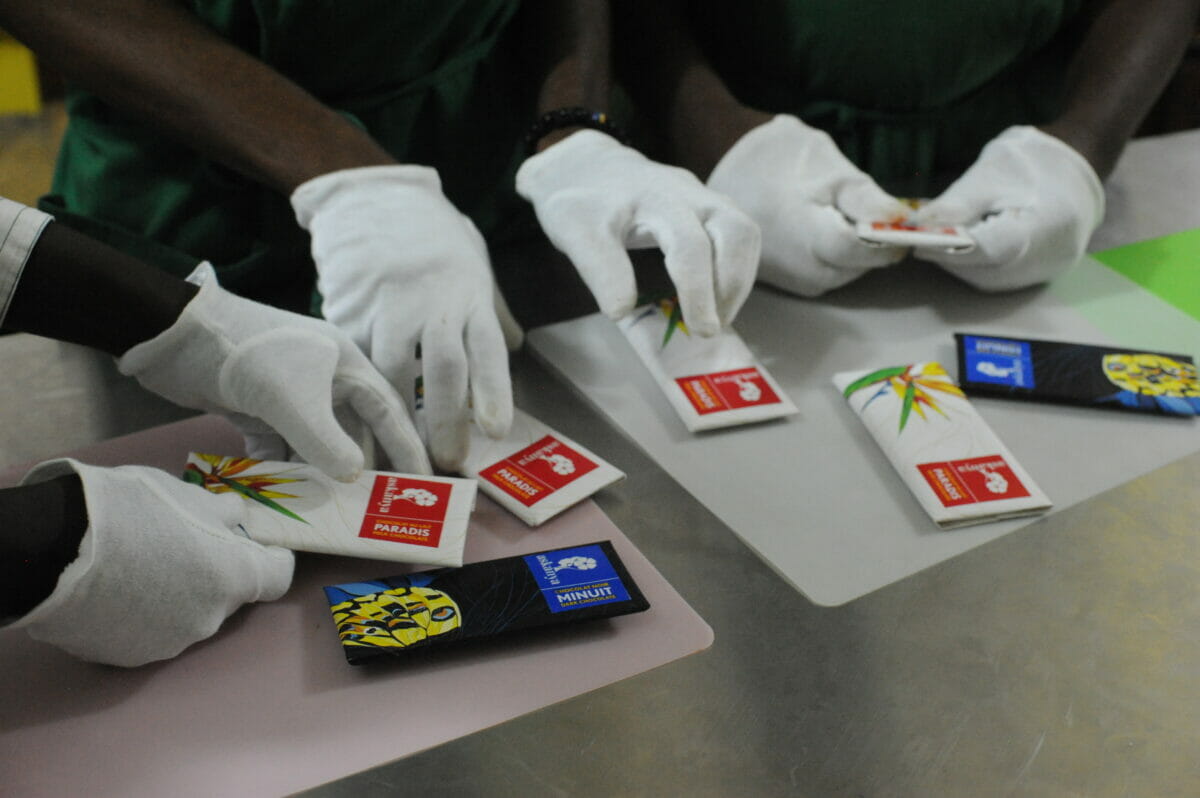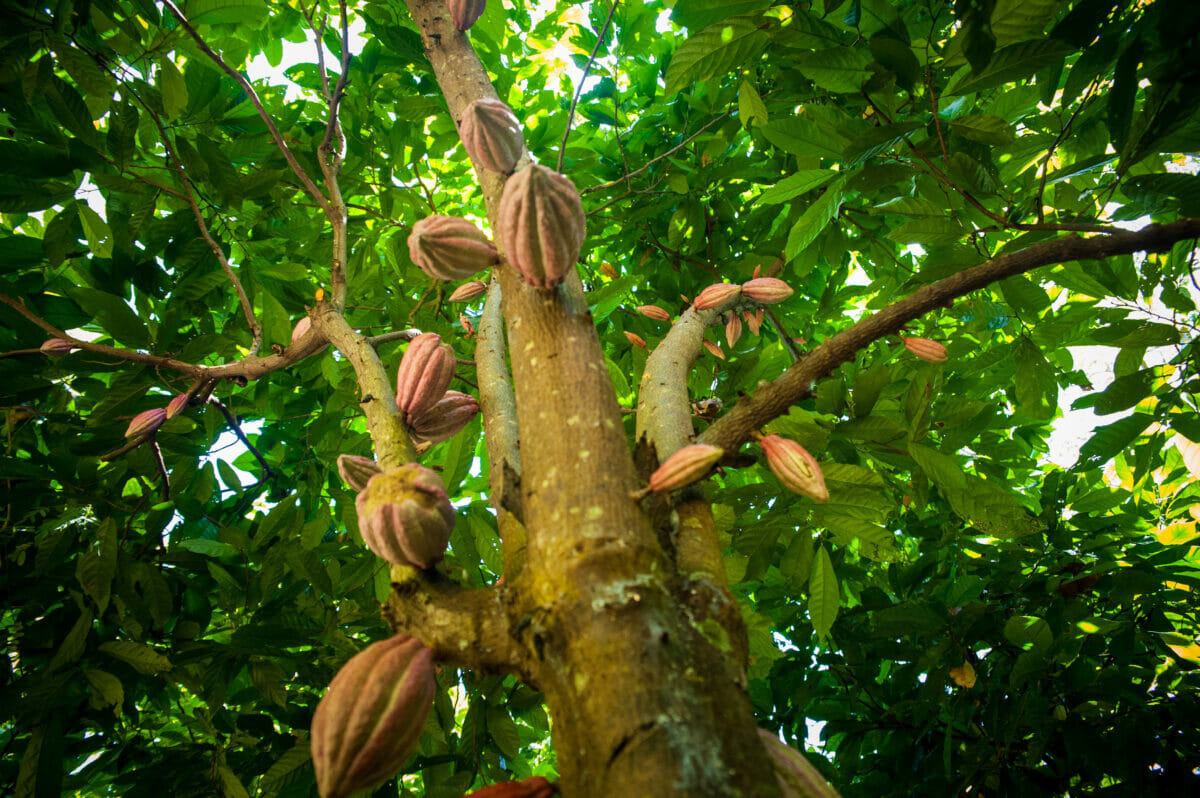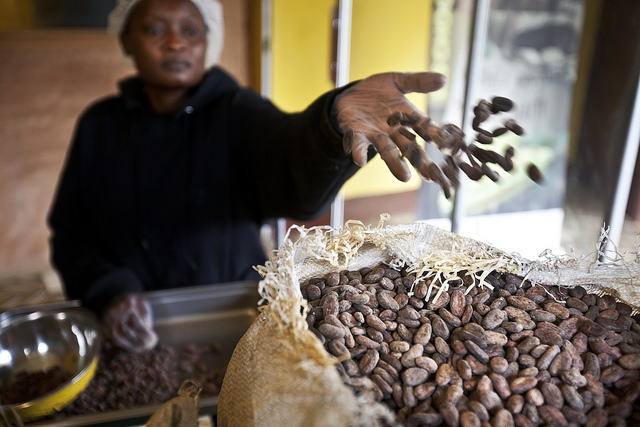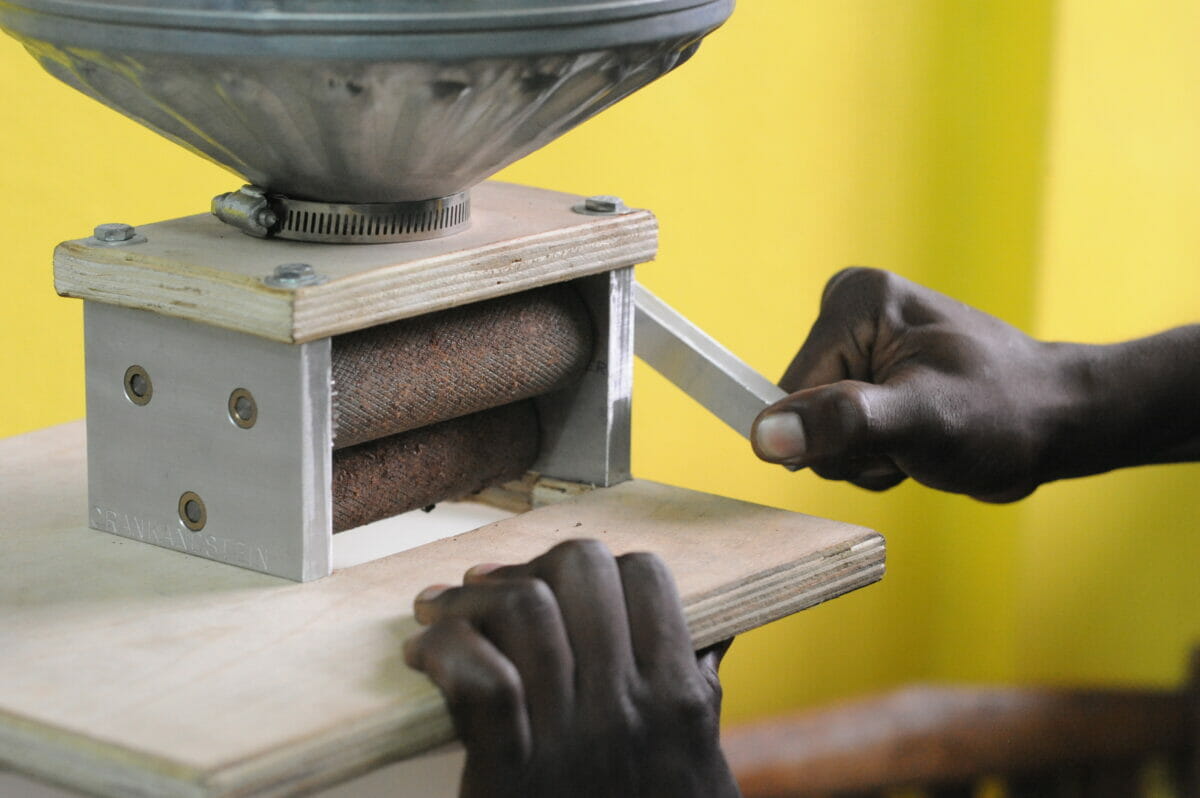The Chocolate Companies Working to Uproot Unfair Labor Practices
Small bean-to-bar producers are trying to shake up the multi-billion-dollar chocolate industry and make a more ethical product.
The Chocolate Companies Working to Uproot Unfair Labor Practices
Small bean-to-bar producers are trying to shake up the multi-billion-dollar chocolate industry and make a more ethical product.

What makes a chocolate bar more ethical than another?courtesy of Askanya Chocolates.
In most countries, cacao pods ripen year round, meaning that harvesting them does, too. The production cycle for chocolate never truly slows down and certainly never stops. Why would it? The global chocolate market is valued at more than $135 billion and continues to grow. That’s good news for manufacturers, who have a consistent demand for products. From giant, corporate producers to small, artisanal shops, chocolate is big business. But that’s often where the similarities end.
The process from harvesting cacao pods to making chocolate from them follows the same basic steps, although each producer will have its own methods. First, cacao pods are harvested from trees, cut straight from the branch with a sharp blade. The pods range in color from brilliant yellow to deep ruby, depending on the plant variety, but they are often about the size and shape of a football. About a week after the pods are harvested, they’re cracked open with a machete or a wooden mallet, splitting the pod in two so that the inner cacao beans can be scooped out. The beans are set out to ferment for another week or so—at which point the material is called cocoa—before they are dried, shipped and ultimately ground down and melted into the chocolate bar you see at the grocery store checkout counter.
Of course, the process is more complicated. Some corporations, such as Mars—known for confectionery items such as Mars bars, Milky Way bars, M&M’s, Snickers and Twix—have been in the business for nearly 100 years, working on a vastly larger scale than smaller brands. And some newcomers to the industry are trying to forge new supply chains and build new relationships in an attempt to build a more ethical chocolate bar because, while the steps of production are roughly consistent around the world, the output of each company varies drastically based on one variation: Who is harvesting the cacao.

When it comes to mass-produced chocolate from major companies such as Mars and Cadbury, much of the cacao is harvested from West African countries such as Ghana and Côte d’Ivoire, where harvesters are often young teens and children, some under the age of 10. According to a 2019 Department of Labor report, more than 1.56 million children working on cacao farms “engaged in hazardous work” such as spraying chemicals and using those sharp knives to collect the cocoa pods.
Despite Hershey, Nestlé and Cadbury publicly addressing the sustainability and ethical issues of harvesting cacao from these areas—including signing the Harkin-Engel Protocol, an agreement that aims to “eliminate child slavery on West African cocoa plantations”—child labor is still used to make mass-market chocolate. In fact, several of those same companies missed deadlines to end child labor in their supply chains in 2005, 2008 and again in 2010.
Child labor and human rights violations were at the heart of two US Supreme Court Cases earlier this year, involving six people who sued the giant food corporations Nestlé and Cargill, claiming the companies either knew, or would have known, about the abuses taking place at the farms from which they purchased cocoa.
One claimant, known as John Doe, wrote a statement at the time of the case, which his lawyer shared with Modern Farmer. In it, Doe claims he was trafficked from his home country of Mali when he was just 14, and taken to Côte d’Ivoire with the promise of a paid job on a cocoa plantation. Instead, he says he was kept enslaved on the plantation along with thousands of other children.
“At night, I was kept in a locked room to prevent me from escaping. Frequently, if the guards felt I was not working quickly enough, I was beaten with tree branches,” wrote John Doe. “I used dangerous chemicals like herbicides, pesticides, and fertilizer without any direction or safety equipment. For all of this hard and dangerous work each day I was never paid and was given scraps of food to sustain me. I was forced to drink dirty water when I was thirsty after working in the very hot weather. I finally escaped when I was 19 years old, but those days still haunt me.”
Doe goes on to question why there isn’t more focus on the inhumane conditions he endured on the cocoa plantation. “I hear that there is a movement called “Black Lives Matter” sweeping the Western world. How come our lives here in West Africa don’t matter? How can it be that child slavery of African children is tolerated so big companies can have cheap cocoa?” Doe wrote.
The Supreme Court threw the cases out saying, in part, that the companies could not be held liable for working conditions that took place outside of the US and for which the companies only made top-level “operational decisions.” Lawyers for the claimants from Mali have filed a new suit against Nestlé, Hershey, Mars and other companies under the Trafficking Victims Protection Reauthorization Act.
In response to an interview request, a Nestlé spokesperson responded with a blanket statement: “Child labor is unacceptable. That is why we are working so hard to prevent it. The Supreme Court agreed there is no basis for this lawsuit to proceed against Nestlé. Nestlé never engaged in the egregious child labor alleged in this suit, and we remain unwavering in our dedication to combatting child labor in the cocoa industry and to our ongoing work with partners in government, NGOs and industry to tackle this complex, global issue. Access to education and improving farming methods and livelihoods are crucial to fighting child labor in cocoa production. Addressing the root causes of child labor is part of the Nestlé Cocoa Plan and will continue to be the focus of our efforts in the future.” Hershey and Cadbury did not respond to interview requests.
If this gives you pause before picking up a box of Halloween candy or makes you second guess that bag of chocolate chips at the grocery store, that might be a good thing. For many smaller chocolate producers, the goal is to reinvent the existing chocolate industry—from the relationships with the cocoa farmers to the way the product is shipped—but many say that will take buy-in from consumers.

“We started doing that education with coffee, like people are OK with buying their cup of coffee for seven dollars,” says Corinne Joachim Sanon Symietz, CEO of Askanya Chocolates, Haiti’s first and only premier bean-to-bar company. “That’s why we like to do events where we can talk to the customers.”
Askanya Chocolates features Haitian cacao, with all bars being produced in Haiti, where Symietz is from. She says her goal was to help subsistence farmers in her home country make enough money to send their children to school, helping to remove one of the main reasons child laborers enter the industry. In order to achieve that, she says Askanya pays cocoa farmers in the area roughly seven times the going rate.
For consumers, that translates into a more expensive product, which Symietz says is the point. “The people that buy our bars are more concerned buyers or more discriminating buyers,” she says. They’re the kind of consumer looking for a product at a higher price point, knowing it comes with certain guarantees about the quality and safety of the food’s supply chain.

Symietz also works directly with cocoa producers in Haiti, sourcing other ingredients—including cane sugar and fruit used to flavor some of the bars—directly from local farmers she’s worked to develop deep relationships with.
The importance of those relationships can’t be overstated, says Gregory D’Alesandre, chief sourcing officer for Dandelion Chocolate in San Francisco. Dandelion sources cocoa from across the globe, but it doesn’t blend them to create a more homogenous flavor. Instead, they approach the process like fine winemaking, ensuring each region’s subtle flavors shine through in their individual bars. And the only way to do that ethically, says D’Alesandre, is to go to these farms, meet the farmers and form a connection with them.
Dandelion publishes a full sourcing report each year, including where cocoa is coming from and details about recent trips to the 14 farms from which they source. The reason for this transparency is simple. “There’s a power imbalance that happens between chocolate makers and cocoa producers, because cocoa producers are generally in developing countries, and they typically have a small handful of customers or they sell to a co-op,” says D’Alesandre. This creates a market where cocoa farmers are often willing to accept low rates from buyers, because they don’t want to lose a valuable customer in a crowded marketplace.
So, at Dandelion Chocolate, the process is simplified. “We pay whatever people tell us to pay,” D’Alesandre says.
By doing this, Dandelion has continued to work with the same farmers and producers around the world for years, highlighting the individual differences of each grower. As a way to highlight the unique family of flavors that come from cacao beans, similar to the terroir of wine grape, the company’s chocolate bars contain only cocoa and cane sugar, with nothing else to muddy the palate. “You wouldn’t say that ‘cheese’ is a flavor. There’s a million types of cheese,” says D’Alesandre. “We want the flavor of those beans to come through. We want people to be able to sort of be transported to the agricultural side of things by tasting our chocolate.”
The last step in producing a more ethical chocolate bar, and arguably one of the most important factors, is focusing on the supply chain. If a manufacturer has a great relationship with a farmer, but the product passes through half a dozen middle men on its way to production, there’s no way to be sure what’s happening at each step. That’s why the Brooklyn-based Beyond Good Chocolate has cut out that step completely. “You can’t work directly with cocoa farmers if you’re not manufacturing in the country of origin,” says CEO Tim McCollum.
Beyond Good’s main cocoa suppliers are in Madagascar, so they built a production facility there. They have more control over the quality of the product, and the farmers make more money without having to deal with other steps. “In Madagascar, farmers almost never do their own fermentation drying. That’s done by an exporter. And we’ve gone in and taught farmers how to do the fermentation drying in the village itself, which is quite rare,” says McCollum. “They’re very good at it, but that was a concerted effort from us to get farmers to that level, because they make a lot more money, they’re adding value to the crop and they’re bought into the whole cycle.”
Beyond Good recently branched out to sourcing from Uganda and says it is working on trimming that supply chain down and wants to commission a chocolate factory in that country next year.
McCollum sees the industry as a whole struggling with “band-aid solutions” such as getting Fair Trade certification or attempting sustainable farming practices. “Inside of big corporations, my sense is that they want to fix the problem. My sense is that they have no idea how to fix it. That they know this is a stain on the industry and on them, but I don’t know that they’re actually asking the right questions and are willing to look within their own businesses and question their entire business model,” he says. Many small chocolate producers agree there’s no need to give up on making chocolate just because several large companies are doing so badly. In fact, that would only hurt the cocoa farmers that rely on that business.
In an industry such as chocolate, bloated with choices and near omnipresent marketing, making an ethical choice might seem difficult. But as these smaller bean-to-bar companies show, it certainly isn’t impossible.
Follow us
This work is licensed under a Creative Commons Attribution-NoDerivatives 4.0 International License.
Want to republish a Modern Farmer story?
We are happy for Modern Farmer stories to be shared, and encourage you to republish our articles for your audience. When doing so, we ask that you follow these guidelines:
Please credit us and our writers
For the author byline, please use “Author Name, Modern Farmer.” At the top of our stories, if on the web, please include this text and link: “This story was originally published by Modern Farmer.”
Please make sure to include a link back to either our home page or the article URL.
At the bottom of the story, please include the following text:
“Modern Farmer is a nonprofit initiative dedicated to raising awareness and catalyzing action at the intersection of food, agriculture, and society. Read more at <link>Modern Farmer</link>.”
Use our widget
We’d like to be able to track our stories, so we ask that if you republish our content, you do so using our widget (located on the left hand side of the article). The HTML code has a built-in tracker that tells us the data and domain where the story was published, as well as view counts.
Check the image requirements
It’s your responsibility to confirm you're licensed to republish images in our articles. Some images, such as those from commercial providers, don't allow their images to be republished without permission or payment. Copyright terms are generally listed in the image caption and attribution. You are welcome to omit our images or substitute with your own. Charts and interactive graphics follow the same rules.
Don’t change too much. Or, ask us first.
Articles must be republished in their entirety. It’s okay to change references to time (“today” to “yesterday”) or location (“Iowa City, IA” to “here”). But please keep everything else the same.
If you feel strongly that a more material edit needs to be made, get in touch with us at [email protected]. We’re happy to discuss it with the original author, but we must have prior approval for changes before publication.
Special cases
Extracts. You may run the first few lines or paragraphs of the article and then say: “Read the full article at Modern Farmer” with a link back to the original article.
Quotes. You may quote authors provided you include a link back to the article URL.
Translations. These require writer approval. To inquire about translation of a Modern Farmer article, contact us at [email protected]
Signed consent / copyright release forms. These are not required, provided you are following these guidelines.
Print. Articles can be republished in print under these same rules, with the exception that you do not need to include the links.
Tag us
When sharing the story on social media, please tag us using the following: - Twitter (@ModFarm) - Facebook (@ModernFarmerMedia) - Instagram (@modfarm)
Use our content respectfully
Modern Farmer is a nonprofit and as such we share our content for free and in good faith in order to reach new audiences. Respectfully,
No selling ads against our stories. It’s okay to put our stories on pages with ads.
Don’t republish our material wholesale, or automatically; you need to select stories to be republished individually.
You have no rights to sell, license, syndicate, or otherwise represent yourself as the authorized owner of our material to any third parties. This means that you cannot actively publish or submit our work for syndication to third party platforms or apps like Apple News or Google News. We understand that publishers cannot fully control when certain third parties automatically summarize or crawl content from publishers’ own sites.
Keep in touch
We want to hear from you if you love Modern Farmer content, have a collaboration idea, or anything else to share. As a nonprofit outlet, we work in service of our community and are always open to comments, feedback, and ideas. Contact us at [email protected].by Emily Baron Cadloff, Modern Farmer
October 25, 2021
Modern Farmer Weekly
Solutions Hub
Innovations, ideas and inspiration. Actionable solutions for a resilient food system.
ExploreExplore other topics
Share With Us
We want to hear from Modern Farmer readers who have thoughtful commentary, actionable solutions, or helpful ideas to share.
SubmitNecessary cookies are absolutely essential for the website to function properly. This category only includes cookies that ensures basic functionalities and security features of the website. These cookies do not store any personal information.
Any cookies that may not be particularly necessary for the website to function and are used specifically to collect user personal data via analytics, ads, other embedded contents are termed as non-necessary cookies.
I’d pay extra for chocolate picked and produced by adults instead of children.
You should look at the work Luker Chocolates are doing in Columbia.